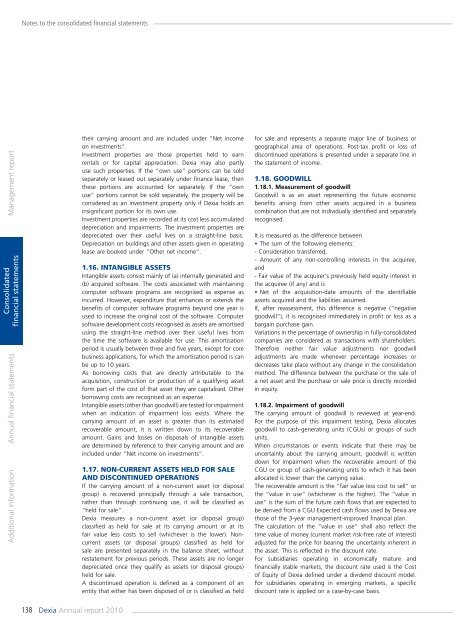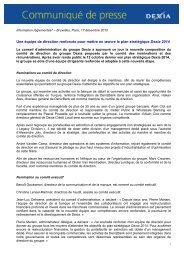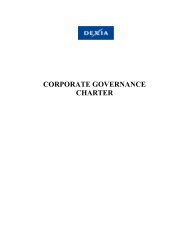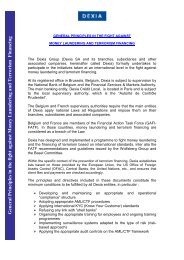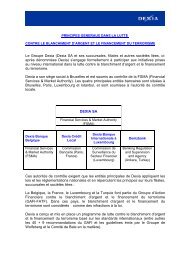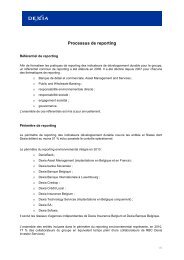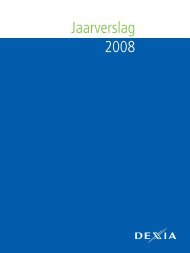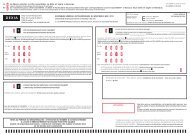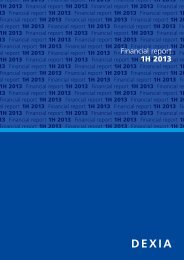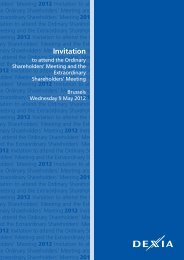Annual report 2010 - Dexia.com
Annual report 2010 - Dexia.com
Annual report 2010 - Dexia.com
- No tags were found...
You also want an ePaper? Increase the reach of your titles
YUMPU automatically turns print PDFs into web optimized ePapers that Google loves.
Notes to the consolidated financial statementsManagement <strong>report</strong>Consolidatedfinancial statementsAdditional information <strong>Annual</strong> financial statementstheir carrying amount and are included under “Net in<strong>com</strong>eon investments“.Investment properties are those properties held to earnrentals or for capital appreciation. <strong>Dexia</strong> may also partlyuse such properties. If the “own use“ portions can be soldseparately or leased out separately under finance lease, thenthese portions are accounted for separately. If the “ownuse“ portions cannot be sold separately, the property will beconsidered as an investment property only if <strong>Dexia</strong> holds aninsignificant portion for its own use.Investment properties are recorded at its cost less accumulateddepreciation and impairments. The investment properties aredepreciated over their useful lives on a straight-line basis.Depreciation on buildings and other assets given in operatinglease are booked under “Other net in<strong>com</strong>e“.1.16. INTANGIBLE ASSETSIntangible assets consist mainly of (a) internally generated and(b) acquired software. The costs associated with maintaining<strong>com</strong>puter software programs are recognised as expense asincurred. However, expenditure that enhances or extends thebenefits of <strong>com</strong>puter software programs beyond one year isused to increase the original cost of the software. Computersoftware development costs recognised as assets are amortisedusing the straight-line method over their useful lives fromthe time the software is available for use. This amortisationperiod is usually between three and five years, except for corebusiness applications, for which the amortisation period is canbe up to 10 years.As borrowing costs that are directly attributable to theacquisition, construction or production of a qualifying assetform part of the cost of that asset they are capitalised. Otherborrowing costs are recognised as an expense.Intangible assets (other than goodwill) are tested for impairmentwhen an indication of impairment loss exists. Where thecarrying amount of an asset is greater than its estimatedrecoverable amount, it is written down to its recoverableamount. Gains and losses on disposals of intangible assetsare determined by reference to their carrying amount and areincluded under “Net in<strong>com</strong>e on investments“.1.17. NON-CURRENT ASSETS HELD FOR SALEAND DISCONTINUED OPERATIONSIf the carrying amount of a non-current asset (or disposalgroup) is recovered principally through a sale transaction,rather than through continuing use, it will be classified as“held for sale“.<strong>Dexia</strong> measures a non-current asset (or disposal group)classified as held for sale at its carrying amount or at itsfair value less costs to sell (whichever is the lower). Noncurrentassets (or disposal groups) classified as held forsale are presented separately in the balance sheet, withoutrestatement for previous periods. These assets are no longerdepreciated once they qualify as assets (or disposal groups)held for sale.A discontinued operation is defined as a <strong>com</strong>ponent of anentity that either has been disposed of or is classified as heldfor sale and represents a separate major line of business orgeographical area of operations. Post-tax profit or loss ofdiscontinued operations is presented under a separate line inthe statement of in<strong>com</strong>e.1.18. GOODWILL1.18.1. Measurement of goodwillGoodwill is as an asset representing the future economicbenefits arising from other assets acquired in a business<strong>com</strong>bination that are not individually identified and separatelyrecognised.It is measured as the difference between• The sum of the following elements:- Consideration transferred,- Amount of any non-controlling interests in the acquiree,and- Fair value of the acquirer's previously held equity interest inthe acquiree (if any) and is• Net of the acquisition-date amounts of the identifiableassets acquired and the liabilities assumed.If, after reassessment, this difference is negative (“negativegoodwill“), it is recognised immediately in profit or loss as abargain purchase gain.Variations in the percentage of ownership in fully-consolidated<strong>com</strong>panies are considered as transactions with shareholders.Therefore neither fair value adjustments nor goodwilladjustments are made whenever percentage increases ordecreases take place without any change in the consolidationmethod. The difference between the purchase or the sale ofa net asset and the purchase or sale price is directly recordedin equity.1.18.2. Impairment of goodwillThe carrying amount of goodwill is reviewed at year-end.For the purpose of this impairment testing, <strong>Dexia</strong> allocatesgoodwill to cash-generating units (CGUs) or groups of suchunits.When circumstances or events indicate that there may beuncertainty about the carrying amount, goodwill is writtendown for impairment when the recoverable amount of theCGU or group of cash-generating units to which it has beenallocated is lower than the carrying value.The recoverable amount is the “fair value less cost to sell“ orthe “value in use“ (whichever is the higher). The “value inuse“ is the sum of the future cash flows that are expected tobe derived from a CGU Expected cash flows used by <strong>Dexia</strong> arethose of the 3-year management-improved financial plan.The calculation of the “value in use“ shall also reflect thetime value of money (current market risk-free rate of interest)adjusted for the price for bearing the uncertainty inherent inthe asset. This is reflected in the discount rate.For subsidiaries operating in economically mature andfinancially stable markets, the discount rate used is the Costof Equity of <strong>Dexia</strong> defined under a dividend discount model.For subsidiaries operating in emerging markets, a specificdiscount rate is applied on a case-by-case basis.138 <strong>Dexia</strong> <strong>Annual</strong> <strong>report</strong> <strong>2010</strong>


